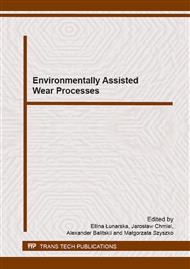p.25
p.33
p.39
p.45
p.53
p.59
p.65
p.71
p.77
Hydrogen Influence on Electrochemical Properties of Gallium Monoselenide
Abstract:
It is experimentally established that illumination of GaSe (Pb) hydrogen saturated layered semiconductor electrodes in acids (H2SeO3, H2SO4) and neutral (water) environments has improved the anode and cathode reactions.The influence of H2SeO3 solution on the potential of open circuit and current density is different for crystals in initial state and after hydrogenation. During the sunlight irradiation, polarization takes place at the low values of current density and more positive value of potentials in comparison with the result obtained in darkness. Taking into account the results, obtained also in the acid H2SO4 environments, we have established that anode and cathode reactions have a slower character and run at the more negative potential values in comparison with the neutral environment.
Info:
Periodical:
Pages:
53-58
Citation:
Online since:
December 2014
Keywords:
Price:
Сopyright:
© 2015 Trans Tech Publications Ltd. All Rights Reserved
Share:
Citation:


